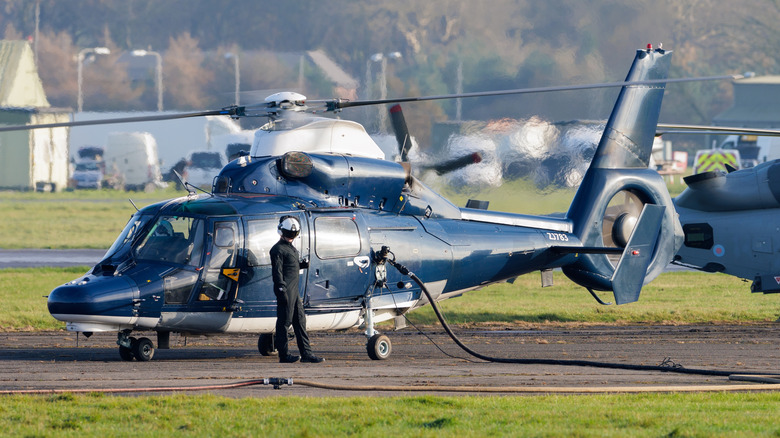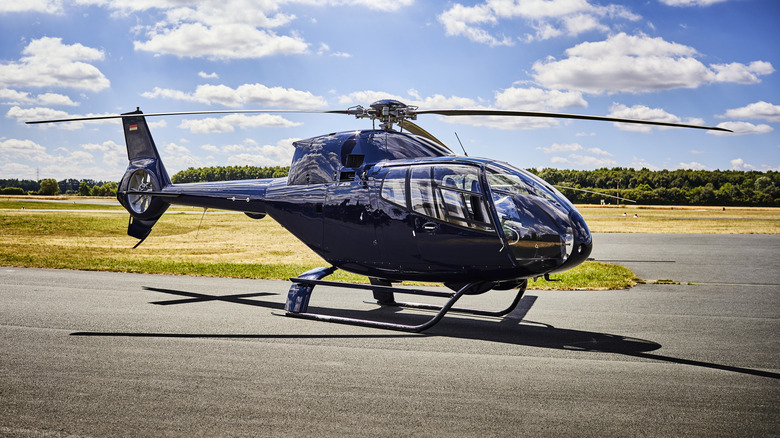
Because of their unique versatility in aerial transportation, helicopters are some of the most important machines of the modern era. Capable of vertical take-off and landing, helicopters are used in more diverse specialized roles than fixed-wing aircraft. Powerful engines enable the helicopter's remarkable capabilities; some helicopters use a type of jet engine called a turboshaft, while others are outfitted with a piston engine. The fuel a helicopter uses depends on which engine type it has.
The
VS 300 by inventor Igor Sikorsky was the first modern helicopter, and it used a piston engine similar to the spark-ignition engines used in cars. The primary difference, however, is that unlike a car or truck, the crankshaft in a helicopter drives the transmission, which turns the rotor system instead of wheels. For turboshaft engines, its power is generated from the combustion of fuel and compressed air, creating a very hot, high-pressure gas that funnels into and powers a turbine. The turbine then converts this into mechanical movement that powers the rotors.
Piston-engined helicopters use a special fuel called avgas, or aviation gasoline, because the engine requires a high-octane fuel with a rating of 100 or more. Avgas is specially formulated for the high-performance requirements of helicopter piston engines and allows for high compression ratios while minimizing the risk of engine knock. Turboshaft engines, on the other hand, need jet A or A1 fuel to run, because of their higher energy density that gives more power to the engine. Jet A fuel is more suited for turboshaft engines because of its low volatility and higher flash point, making it safer to use.
Read more: 10 Of The Strangest Military Helicopters Ever Made
More Efficient Fuel For Helicopters

While both avgas and jet A fuel are used in helicopters, there are key differences between the two, starting with composition. Avgas is a petroleum product that resembles gasoline and is available in several grades from 80 to 100LL, each with a distinct color. Avgas also contains additives like tetraethyl lead and other chemicals that act as antioxidants and increase its octane rating. Jet A fuel, in contrast, is obtained from kerosene and is blended with several hydrocarbons from C9 to C16. Lastly, jet A fuel is less costly than avgas because it's easier and cheaper to produce and transport, and it's also subjected to a more thorough refining process to deliver better performance.
Alongside the two main fuels that are derived from petroleum refining, developments in fuel technology have provided new alternative fuel sources for helicopters. Called sustainable aviation fuel (SAF), these are fuels made from non-petroleum sources, including agricultural products like corn, forest wood wastes, used oil, urban solid waste, and even algae. These waste products are then treated and processed in different ways to produce fuel, including hydrotreatment for oil-based waste, alcohol-to-jet for removing oxygen from ethanol or butanol by-products, and CO₂ capture that produces e-fuel.
Compared to fixed-wing aircraft, helicopters are less fuel-efficient, and their average fuel consumption varies depending on their engine type. Piston engine choppers consume between five and 20 gallons an hour, while turbine-powered helicopters can consume 25 to over 1,000 gallons an hour. Because of these large fuel requirements, more eco-friendly fuel sources like SAF are more valuable, providing an alternative to fossil fuels that produce less emissions and come from renewable resources.
Want the latest in tech and auto trends? Subscribe to our free newsletter for the latest headlines, expert guides, and how-to tips, one email at a time.
Read the original article on SlashGear.










